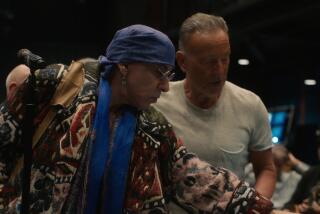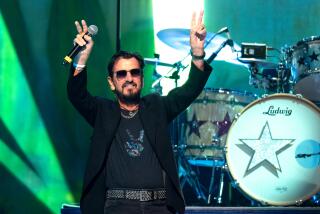Clarence Clemons dies at 69; saxophonist for Bruce Springsteenâs E Street Band
Saxophonist Clarence Clemons, an indispensable part of Bruce Springsteenâs E Street Band both for his full-throttle tenor sax work and his larger-than-life onstage persona as âthe Big Man,â died Saturday. He was 69.
Clemons, who put his stamp on such Springsteen staples as âBorn to Run,â âJunglelandâ and âRosalita,â died in a Palm Beach, Fla., hospital of complications from a massive stroke he suffered June 12 at his Florida home, a spokeswoman for Springsteen and the E Street Band said.
âClarence lived a wonderful life. He carried within him a love of people that made them love him. He created a wondrous and extended family,â Springsteen said in a statement Saturday. âHe was my great friend, my partner and with Clarence at my side, my band and I were able to tell a story far deeper than those simply contained in our music. His life, his memory, and his love will live on in that story and in our band.â
Photos: Clarence Clemons | 1942-2011
Clemonsâ career was inextricably linked to his decades playing alongside Springsteen, but he also became an in-demand player and presence for other musicians including Jackson Browne, Ringo Starr, Aretha Franklin and, most recently, Lady Gaga, with his appearance on her mega-hit album âBorn This Way.â
But every musical road Clemons traveled always seemed to lead back to E Street.
âEvery time we get together, itâs all brand-new,â Clemons told the Associated Press last year. âEvery time, Bruce comes back with something new and something different. I keep wondering: How high can he take it? ... How many times can he be reborn? I just want to keep on living so I can keep seeing the change.â
Clarence Clemons was born Jan. 11, 1942, in Norfolk, Va., the son of a fish merchant who bought him an alto saxophone for Christmas one year, instead of the electric train heâd asked for.
âIâd never even seen a saxophone before, and didnât really know why my father gave it to me,â Clemons once told DownBeat magazine. And even though his father also arranged for him to take lessons, Clemons recalled that âmy dad made me practice in the backroom of the store, while the other kids were out playing baseball, and I hated it.â
That changed when he was a teenager. Heâd switched to baritone sax and played in the Crestwood High School jazz band, but after his uncle gave him a record by celebrated R&B session player King Curtis, Clemons was hooked on tenor, the instrument favored in early rock and R&B bands.
âHe turned me on, and it was then that I decided I wanted to play tenor,â Clemons recalled later. âHis sound and tone were so big on those sessions he did, and his feeling was right from the heart. Here was a guy who gave me something.â
A music and football scholarship took Clemons to what is now the University of Maryland Eastern Shore, where he majored in sociology while still dreaming of playing in the NFL. After graduating, he moved to Newark, N.J., and took a day job counseling emotionally disturbed youths. At night he plied the bars and nightclubs with his saxophone.
In Asbury Park one night, he went to a bar a block from the one where heâd been booked to check out a scrawny local musician heâd been hearing about.
âI had my saxophone with me, and when I walked in this club â no lie â a gust of wind just blew the door down the street. Boof!,â Clemons told People magazine. âI say, âI want to play. Can I sit in?â Bruce says, âHey, you can do anything you want. Take a couple of background singers, anything.â
âI sat in with him that night,â Clemons said. âIt was phenomenal. Weâd never even laid eyes on each other, but after that first song, he looked at me, I looked at him, and we said, âThis is it.â After that I was stoked.â
The E Street Band was in place when talent scout John Hammond signed Springsteen to Columbia Records in 1972. The groupâs first two albums were lyrically effusive affairs that led to Springsteenâs being tagged as yet another ânew Dylan.â Musically the songs wedded rock, folk, R&B, soul and gospel strains.
Clemonsâ sax figured prominently in early tracks such as âSpirit in the Nightâ and âRosalita,â which became core tunes of the bandâs live shows. But the albums sold modestly and didnât crack Billboardâs Top 200 chart until after âBorn to Runâ cemented Springsteen as a new hero in the rock mainstream.
Clemonsâ contributions were powerfully woven into the songs on âBorn to Run,â which were given a new Phil Spector-like sonic grandeur by Springsteen and the albumâs co-producers.
While Clemonsâ beefy tenor sax work was central to Springsteenâs new sound, he brought an imposing presence onstage, where he often served as a playful and big-hearted foil to the bandâs leader. His nickname was anything but merely honorary â he stood 6 feet 2 and weighed anywhere between 250 and 300 pounds.
Springsteen invoked his place in the band in another song from that album, âTenth Avenue Freeze-Outâ: âWhen the change was made uptown and the Big Man joined the band/From the coastline to the city all the little pretties raise their hands.â Itâs Clemonsâ mighty shoulder that Springsteen is leaning on in the cover photograph.
Continuing on âDarkness on the Edge of Town,â 1980âs two-disc set âThe Riverâ and 1984âs âBorn in the U.S.A.,â Clemonsâ sax was as integral to the music as Springsteenâs raspy voice and twanging Telecaster guitar, Max Weinbergâs thunderous drumming and Roy Bittanâs elegant piano work.
They helped Springsteen climb to the top of the pop music mountain in the 1980s with âBorn in the U.S.A.,â which spent seven weeks at No. 1; a five-disc live set that also topped the charts for seven weeks; and âTunnel of Love,â the triple-platinum 1987 album that also went to No. 1.
Clemons recorded his first solo album in 1983, which gave him a new role at center stage. âI love the responsibility of fronting my own band,â Clemons told the Ottawa Sun in 2003. âCreating my own audience is fun, developing my own ideas and carving out my own space.â
He further established an identity away from E Street by playing on Franklinâs 1985 hit âFreeway of Love,â the same year he scored a Top 20 hit with his duet with Browne on âYouâre a Friend of Mine.â
Yet through those side ventures, there was always the E Street Band to come back to. That changed in 1989, when Springsteen decided he was ready to move on musically and informed the E Streeters that he was mothballing the band.
âSpringsteen said he wanted to try something new, do something different,â Clemons told the Phoenix Gazette. âIt was quite a shock; you go through all the emotions of a divorce, all the emotions, instantly. I didnât say much to him. I just said, âGood luck.â But before long I started to see the good side.â
In 1989 he joined ex-Beatle Starr, pianist-singer Dr. John, the Bandâs drummer Levon Helm, E Street Band guitarist Nils Lofgren, Joe Walsh and others on a tour he described as âone of the most joyous times of my life.â
After a decade in solo settings and other band configurations, Springsteen decided it was time to reconvene the E Street Band.
âThatâs the way we always work,â Clemons told a reporter last year. âYou get that call, you show up.â
Clemons in recent years had to contend with health issues including two hip replacements, and knee and back surgeries. In the â70s he had a reputation as a rock ânâ roll party animal, but in later years he adopted a healthier lifestyle, exploring Eastern philosophies, exercising regularly and meditating daily. Still, his ailments restricted him onstage during the physically grueling E Street Band shows.
In 2009 he published his autobiography, âBig Man: Real Life & Tall Tales,â in which he addressed the pain he felt when Springsteen put the band on hold â not knowing at the time whether theyâd ever play together again. He also wrote about the sense of acceptance he eventually developed about his role in one of rockâs most celebrated groups.
âItâs fine for me to be known as part of the E Street Band,â he told the New York Daily News. âWe all wonder what weâre here to do. Something got me into a band with Bruce. Itâs where I belong.â
Survivors include his fifth wife, Victoria, and four sons.
Photos: Clarence Clemons | 1942-2011
More to Read
Start your day right
Sign up for Essential California for the L.A. Times biggest news, features and recommendations in your inbox six days a week.
You may occasionally receive promotional content from the Los Angeles Times.






